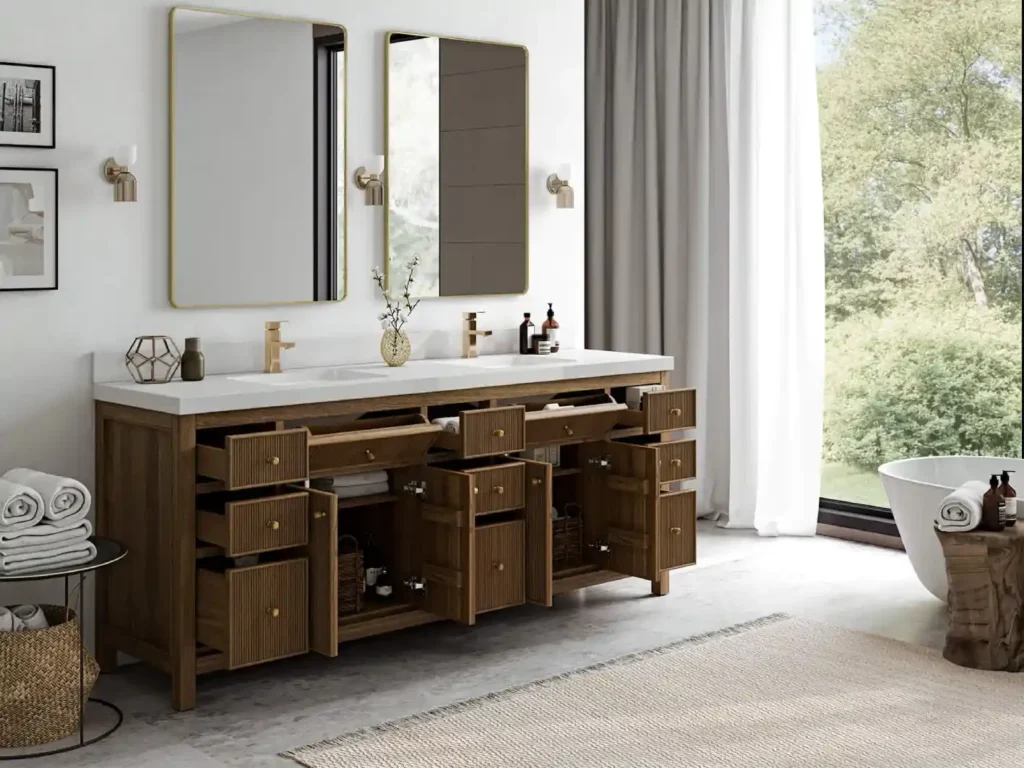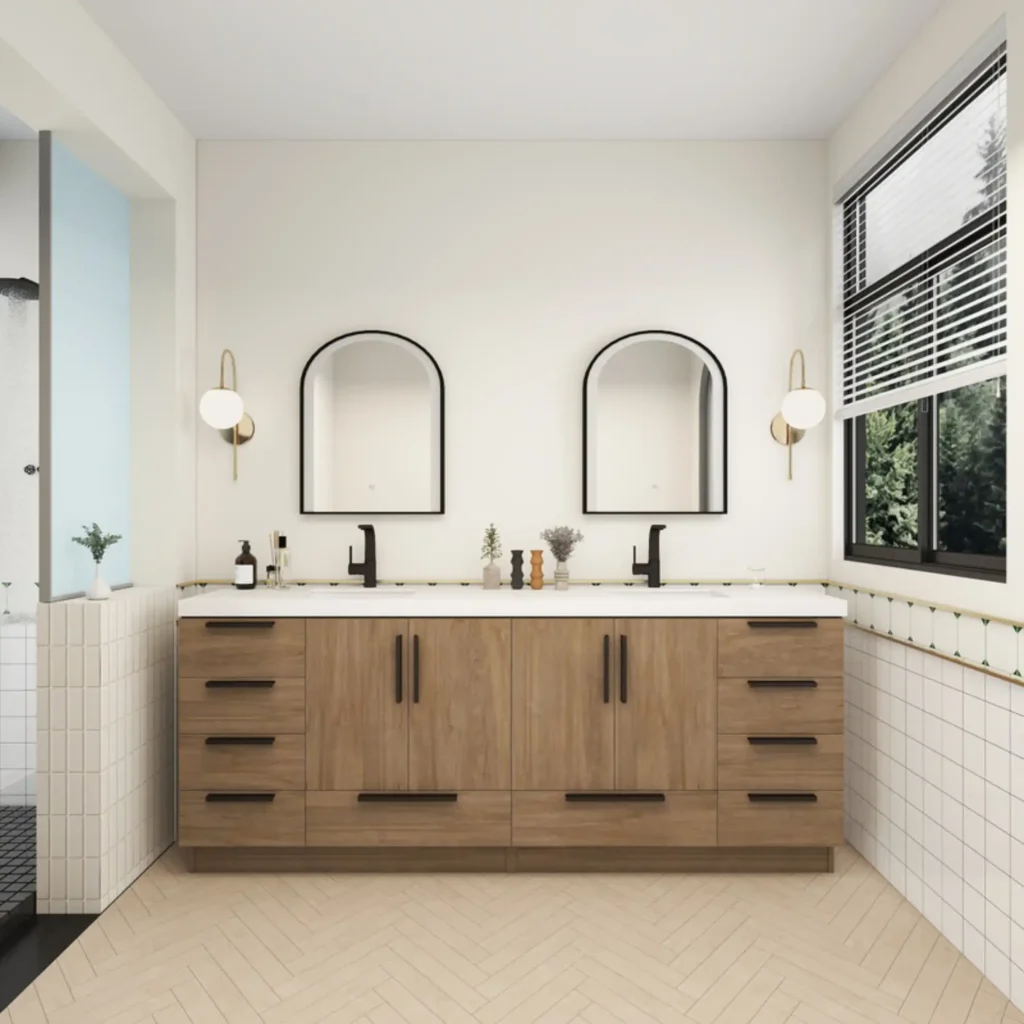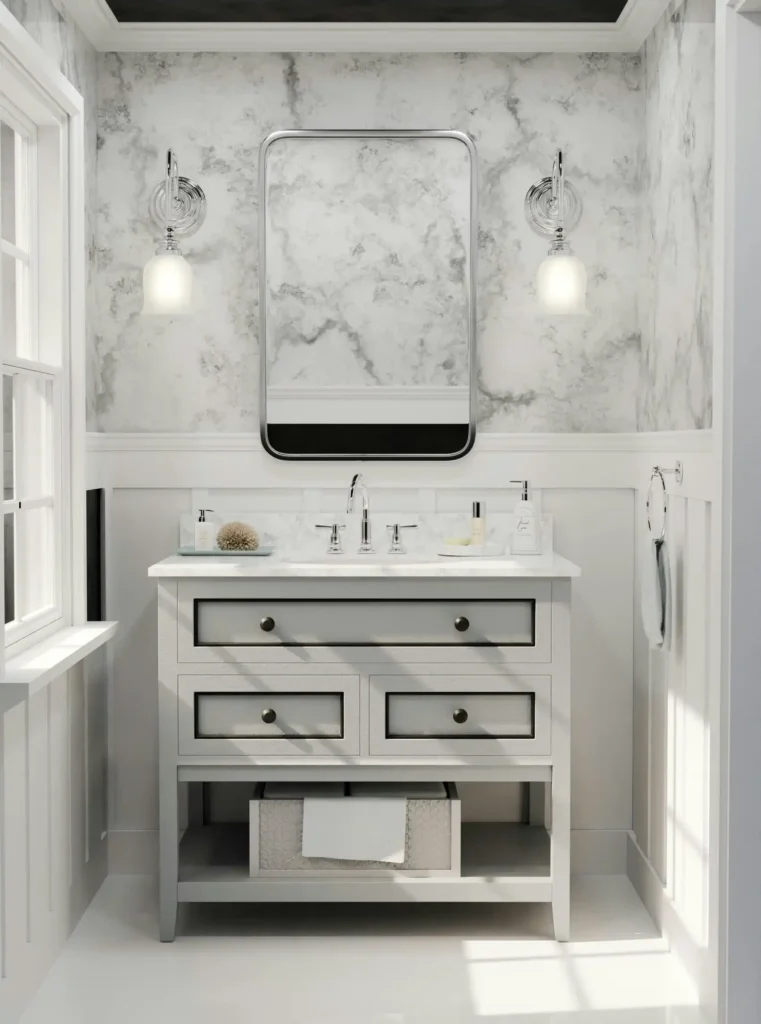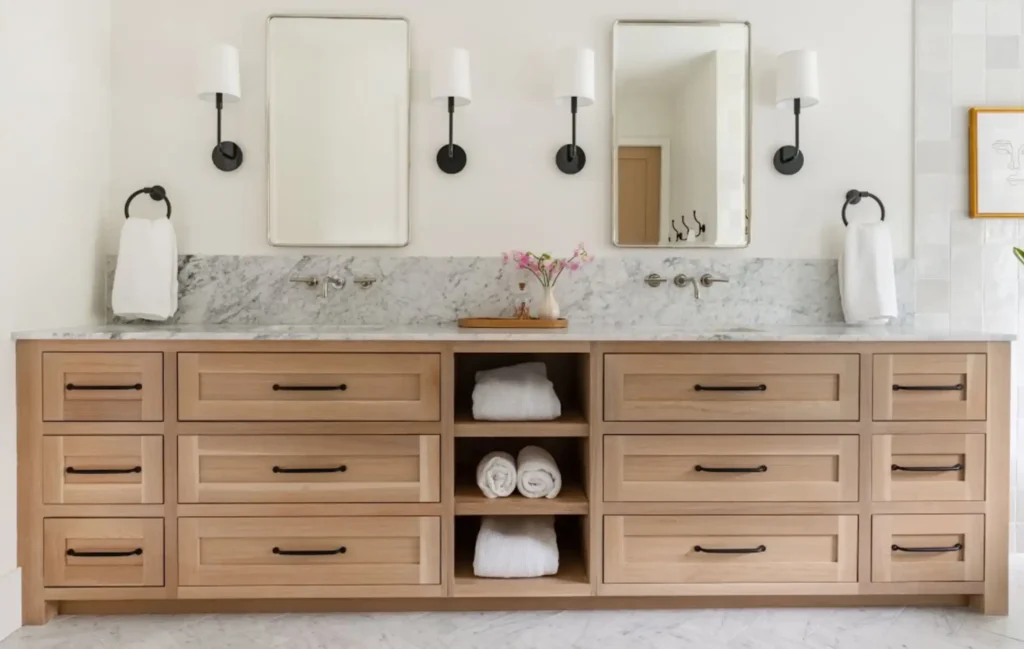What is vanity in bathroom? Unlike what many people assume, a bathroom vanity is more than just a sink. It’s a combination of the countertop, sink, and storage cabinet, all into one piece of furniture.
In your bathroom vanity installation project, you’re adding more than just a sink — you’re installing an important element that brings both style and function to the space. A vanity serves as a practical workspace where you can go about your daily routines, like brushing your teeth, washing your face, or applying makeup and doing skincare.
Choosing the right vanity can transform your bathroom in so many ways including practicality and beauty.
To truly understand what is vanity in bathroom and why it matters, keep reading this blog for all the details you need.
What Is Vanity in Bathroom?
So, what is vanity in bathroom? Think of it as the stylish centerpiece of your bathroom — a functional piece of furniture that includes:
- Sink: This can be a single or double sink above or under the counter top of your vanity.
- Countertop: The surface around the sink where you place daily-use items such as soap, toothbrushes, skincare and cosmetics.
- Cabinetry/Storage: Cabinets or drawers beneath the countertop for storing bathroom necessities.
Keep in mind that you can always add more storage like drawers or cabinets underneath. It helps you stay organized while designing your space.
A bathroom vanity is more than just a piece of furniture—it’s the focal point where your daily routines begin. From washing your hands to applying makeup and following your skincare routine, the vanity is where it all happens. The vanity not only holds the sink but also hides all the plumbing and offers essential storage for toiletries, cleaning supplies, and other bathroom must-haves.
The perfect blend of function and style, a bathroom vanity is far more than a simple cabinet or basin—it’s the heart of your bathroom’s design and utility.
Some bathroom vanities come with additional features like built-in mirrors and lighting, power outlets, and open shelves to have a more functional and beautiful space.
Why Is the Vanity Important in a Bathroom?
Many assume a bathroom vanity is just a place to hold the sink—but that’s a common misconception. So, what makes the bathroom vanity such an important part of your bathroom? Once you discover the answer, you’ll start to see it in a whole new light.

That is why understanding what is the vanity in the bathroom helps you understand its role. The bathroom vanity comes with several benefits including:
- Hides plumbing: Vanities hides all the pipes and plumbing fixtures for a cleaner look.
- Provides storage: Bathroom vanities keep your bathroom clear out of any mess by storing items out of sight.
- Offers workspace: The countertop gives you space to place items.
- Enhances design: Vanities are available in many styles and finishes, which can be an important part of bathroom design.
Now you see why having a vanity is so important— people mostly use it to create a stylish bathroom with lots of storage since all vanities cleverly hide pipes and plumbing.
Different Types of Bathroom Vanities
Now that you know what is vanity in bathroom, there are several types of vanities to choose from. Each of these vanities are suited to different bathroom layouts and styles which include:
- Freestanding Bathroom Vanity: Standalone units that are not attached to the wall are commonly known as A freestanding bathroom vanity. It looks like a piece of furniture, such as a dresser or cabinet, and can be moved if needed. Freestanding vanities are popular for their being classic and free of installing professional work. They work well in both traditional and modern bathrooms.
- Wall-Mounted Vanity: Wall-mounted vanities are attached directly to the wall to create a floating effect. This style is great for small bathrooms because it frees up floor space and makes the room feel larger. It also makes cleaning underneath easier.
- Corner Vanity: For a small bathroom with limited space, a corner vanity is a smart choice. It fits neatly into a corner to maximize the use of space without crowding the room.
- Double Vanity: For larger bathrooms or shared spaces, a double vanity with two sinks provides convenience for two users at once. This type usually starts at 60 inches wide or more perfect for a lovely couple sharing the same bathroom.
Now you may be wondering how you can design a bathroom vanity — clearly, this isn’t something you can easily do on your own. What you need is an expert team like Silktouch Joinery to handle everything for you.
Silktouch Joinery is a Melbourne-based company that specializes in all aspects of home renovation and design projects. So yes, it’s not just about the bathroom vanity — it’s about transforming your entire space.
Silktouch not only takes care of your bathroom vanity project but also offers services including:
- Interior design & consultation services,
- Custom kitchen cabinets,
- Laundry storage solutions,
- Wardrobes,
- Wall-units,
- Along with home renovation projects.
What Is the Best Material for a Bathroom Vanity Top?
When it comes to bathroom vanity materials, being waterproof must be your top priority. And guess what materials and finishes are usually waterproof? Bright stones. The overall materials include:

- Quartz: Quarts are not only durable, but they are also Water-resistant (slightly less strong than waterproof), and easy to care for.
- Granite: This is a very luxurious natural stone with unique patterns. Granits are very durable but require sealing.
- Marble: Marbles are Elegant and classic but they soak up water and stains easily.
- Solid Surface (e.g., Corian): While they are affordable with Seamless appearance, they are also super easy to repair.
- Laminate: Budget-friendly and available in many styles but less durable.
- Ceramic or Porcelain: Super affordable, Ceramics are often chosen for sinks and countertops made as one piece.
Overall, quartz is the most popular option for your bathroom vanity due to its durability, and its resistance to water.
What Is the Best Lighting for a Bathroom Vanity?
While many people may tease the effect of good lighting for your bathroom vanity, it’s one of the best ways to add some sparkly vibe to your bathroom.
The best lighting for you bathroom vanity include:
- Mirror-side vanity lights: Provide even, shadow-free lighting.
- LED lights: Super long-lasting and power saving.
- Natural light: It’s best to position the vanity near a window to use the natural light with visibility.
- Layered lighting: Merge and combine light over your head and above the ceiling for more flexibility.
Try to avoid harsh, single-source lighting as much as possible. Single lighting creates shadows on your face, which can make your mood unpleasant. Instead, use lights at eye level on either side of the mirror or a well-placed light bar above the mirror.
What Is the Standard Height for a Bathroom Vanity?
Now that you have understood what is a bathroom vanity, you should also know the standard height for your vanity. The standard height for a bathroom vanity is typically between 30 and 36 inches.

The range for your vanity height is designed to be comfortable for users of varying heights. However, there are some new trendy designs called “comfort height” vanities. These are closer to 36 inches tall to reduce bending and improve ergonomics, especially for taller individuals.
Conclusion
Now that you know what is vanity in bathroom, you also need to know that bathroom vanities are not only stylish, but they are also space-saving in a practical way. Floating designs with under-cabinet lighting, and smart features like LED mirrors can be the trending part of your bathroom. You can use popular Materials and finishes like marble, matte black, and quartz to make your bathroom vanity have a long lasting beauty. If you still have no idea on what to do with your bathroom vanity, you can start following our page on Instagram for new ideas.
FAQs
1. What Is a Floating Vanity and Why Is It So Popular?
A floating vanity is a wall-mounted bathroom cabinet that has open space underneath to create a modern look with more storage. It is popular because it increases the bathroom’s openness, and you can clean under your bathroom vanity very easily without bothering yourself.
2. What Materials Are Trending for Bathroom Vanities?
The Most trendy materials are bamboo, hard-wood, FSC-certified wood, and recycled glass. These materials combine environmental responsibility with aesthetic appeal, adding warmth and texture to bathroom designs.
3. Are There Any Smart Features Integrated into Bathroom Vanities?
Yes, modern vanities often include smart technology including mirrors with built-in LED lighting, touch-activated fixtures, and temperature-controlled drawers for towels, making them both practical and luxury.
4. How Customizable Are Bathroom Vanities?
Customization is a major trend in bathroom design, with options to tailor the size, color, storage layout, and finishes of vanities. This allows homeowners to create personalized pieces that perfectly match their space and style preferences.
